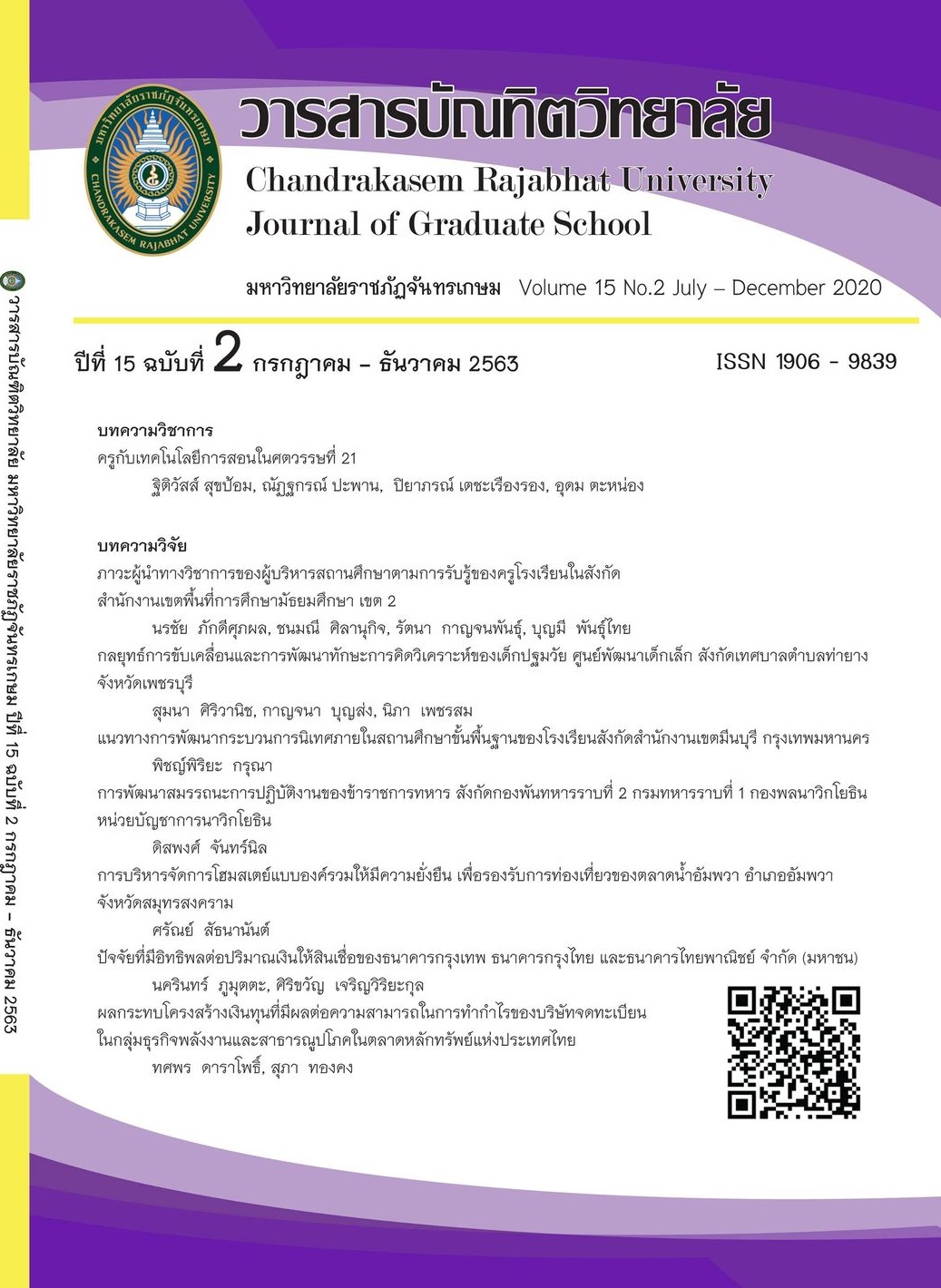ครูกับเทคโนโลยีการสอนในศตวรรษที่ 21
Main Article Content
บทคัดย่อ
ประเทศไทยได้พัฒนาเพื่อก้าวเข้าสู่ยุคเศรษฐกิจ 4.0 ไปแล้ว ด้านภาคการศึกษา ถือว่าเป็นยุคที่ต้องสร้างนวัตกรรม โดยส่งเสริมให้ผู้สอนและผู้เรียน เป็นนักคิดและนักสร้างนวัตกรรม ตามนโยบายการขับเคลื่อนประเทศไทยด้วยเทคโนโลยี
ปัจจุบัน ข้อมูลและสื่อต่าง ๆ มีการเผยแพร่ ค้นหาและส่งต่อได้อย่างอิสระ จนถึงขั้นกล่าวเปรียบเปรยว่า “ข้อมูล” เปรียบเสมือนตัวแปรต้น “นักเรียนนักศึกษา” เปรียบดังตัวแปรตาม โดยที่ “ครู”นั้น เสมือนหนึ่งตัวแปรควบคุม[1] การจะพัฒนาผู้เรียนให้มีคุณภาพตามวัตถุประสงค์ในศตวรรษที่ 21 นี้ ครูและนักเรียนต้องสามารถเปลี่ยนแปลงข้อมูลต่าง ๆ ในสังคมออนไลน์หรืออินเตอร์เน็ตให้กลายเป็นสารสนเทศและองค์ความรู้ในที่สุด โดยครูและนักเรียนต้องสัมพันธ์อิงอาศัยกันและกัน โดยเฉพาะ“ครู”ต้องมีคุณลักษณะประกอบด้วย (1) ต้อง“เป็นผู้สร้างและผู้ผลิต” ต้องแสดงให้เห็นแนวทางการพัฒนาทักษะความเป็นครูได้ ต้องผ่านทักษะกระบวนการฝึกอบรมและเรียนรู้ด้านเทคโนโลยีสารสนเทศ อีกทั้งต้องตระหนักในตนเองถึงบทบาทความเป็นครู ฝึกฝนพัฒนาตนเองโดยใช้กระบวนการวิจัยเป็นฐานการพัฒนา แก้ไขปัญหาส่วนพร่องและขจัดปัญหาส่วนเกิน คอยตรวจสอบประเมินผลจากรูปแบบการส่งเสริมและพัฒนาเป็นระยะเวลาอย่างต่อเนื่อง และ (2) ต้อง“เป็นผู้คิดริเริ่มและสร้างสรรค์” มีความรู้และความสามารถเกี่ยวกับเทคโนโลยีประยุกต์เข้ากับเนื้อหาการสอนเพื่อเพิ่มประสิทธิภาพการสอนและทักษะทางสารสนเทศในการจัดการเรียนการสอน รองรับการสร้างนวัตกรรม บริหารจัดการชั้นเรียน รวมถึงสามารถถ่ายทอดความรู้ไปสู่ศิษย์ในแนวใหม่ในทักษะด้านต่าง ๆ ที่จำเป็นเพื่อการดำเนินชีวิตและการใช้ทักษะอาชีพผ่านเทคโนโลยี
ครู ในศตวรรษที่ 21 นี้ เน้นแบ่งปันองค์ความรู้เสริมสร้างประสบการณ์ พัฒนาศักยภาพด้านความรู้ ทักษะ ความสามารถ รังสรรค์องค์ความรู้สร้างคุณค่าให้ตนเองส่งต่อให้ผู้เรียน ผ่านรูปแบบจัดการเรียนการสอนแนวใหม่โดยใช้เทคโนโลยีเป็นสื่อ ส่งเสริมทักษะใหม่ให้กับผู้เรียน ทักษะด้านเทคโนโลยีสารสนเทศ เป็นทักษะที่จำเป็นสำหรับการรับมือต่อการเปลี่ยนแปลงของโลกและสังคมในอนาคต “ครู” จึงเป็นดุจผู้นำสังคมตามลักษณะ “ตัวแปรควบคุม” ในศตวรรษที่ 21 นี้ กอปรยุคประเทศไทย 4.0 ครูถือว่าเป็นบุคลากรที่สำคัญของประเทศที่สามารถนำทาง ชี้ช่องทางนำมาซึ่งองค์ความรู้ได้ ดังนั้น ครูจึงต้องมีความรู้รอบและทักษะครอบคลุมความสามารถด้านเทคโนโลยีสารสนเทศ ทั้ง 4 มิติ ได้แก่ การใช้ การเข้าใจ การสร้าง และการเข้าถึง สามารถนำมาจัดการเรียนการสอน ได้อย่างมีประสิทธิภาพสูงสุดในยุคที่ถูกกล่าวถึงว่า “โลกไร้พรมแดน”
[1] ตัวแปรต้น (หรืออีกชื่อคือ ตัวแปรอิสระ) คือตัวแปรที่กำหนดขึ้นเพื่อทดสอบสมมติฐาน เป็นตัวแปรที่เราเปลี่ยนไปเพื่อจะดูผลที่ตามมา (พูดง่ายๆ คือสิ่งที่ต้องทำให้ต่างกัน) ตัวแปรตาม คือ ตัวแปรที่เปลี่ยนไปตามตัวแปรต้น พูดง่ายๆก็คือผลของตัวแปรต้นนั่นเอง เป็นตัวแปรที่เราต้องเก็บค่า บันทึกผล (สิ่งที่เราต้องตามผล) ตัวแปรควบคุม คือ ตัวแปรที่ส่งผลต่อการทดลอง อาจทำให้การทดลองของเราคลาดเคลื่อน จึงต้องควบคุมเอาไว้ (สิ่งที่ต้องทำให้เหมือนกัน)
Article Details

อนุญาตภายใต้เงื่อนไข Creative Commons Attribution-NonCommercial-NoDerivatives 4.0 International License.
เอกสารอ้างอิง
จุฬารัตน์ ธรรมประทีป. (2562). การใช้ ICT ในห้องเรียนวิทยาศาสตร์: บทบาทครูสำคัญต่อความสำเร็จในการใช้ ICT. สืบค้นจาก https://adacstou.wixsite.com/adacstou.
จักริน บูรณะนิตย์. (2560). เทคโนโลยีการศึกษาสำหรับครูไทยยุค 4.0. สืบค้นจาก https://medium.com/opencurriculum/9-เทคโนโลยีการศึกษา-สำหรับครูไทยยุค-4-0-3f364235a443.
ฐิติวัสส์ สุขป้อม. (2561). มารยาทที่ดีสำหรับครู. คณะศึกษาศาสตร์ มหาวิทยาลัยราชภัฎจันทรเกษม.
สืบค้นจาก http://departmentsecretary.freeoda.com/Marayatthai/index.html.
ณรงค์ เพชรล้ำ. (2558). แนวทางการจัดทักษะการเรียนรู้ในศตวรรษที่ 21 ที่เน้นสมรรถนะสาขาวิชาชีพ. กรุงเทพฯ: โรงพิมพ์ชุมนุมสหกรณ์การเกษตรแห่งประเทศไทย จำกัด.
ณัฏฐ์ณรัณ แคล่วคล่อง. (2560). สรุปสาระสําคัญจากการจัดกิจกรรมแลกเปลี่ยนเรียนรู้เรื่อง “Learn in Line” .กรุงเทพฯ: คณะพยาบาลศาสตร์ มหาวิทยาลัยมหิดล.
พรชัย ภู่ประเสริฐ. (2562). ทักษะมนุษย์ที่ต้องปรับตัวให้ทันในยุคศตวรรษที่ 21. สืบค้นจาก https://www.youtube.com/embed/O21WWndZDrI.
นิรมิษเพียร ประเสริฐ. (2560). SMART CLASSROOM: ห้องเรียนในยุค 4.0. สืบค้นจาก http://oho.ipst.ac.th/smart-classroom-4-0-part2.
บัณฑิต เอื้ออาภรณ์. (27 มีนาคม 2562). จี้มหา"ลัยปรับตัวก่อนที่จะล่มสลาย. เดลินิวส์ออนไลน์. สืบค้นจากhttps://www.dailynews.co.th/education/700971.
ฟาฏินา วงศ์เลขา. (3 พฤศจิกายน 2558). การจัดการเรียนการสอนในยุคโลกดิจิตอล. เดลินิวส์ออนไลน์. สืบค้นจาก https://www.dailynews.co.th/education/358284.
ภาสกร เรืองรอง. (2559). การฝึกอบรมเรื่องการสร้างแบบประเมินออนไลน์โดยใช้ Google site ร่วมกับการเรียนรู้แบบร่วมมือ, วารสารวิทยาลัยพยาบาลบรมราชชนนี อุตรดิตถ, 8 (2), 86-94.
วิจารณ์ พานิช. (2555). ทักษะเพื่อการดำรงชีวิต ในศตวรรษที่ 21. กรุงเทพฯ: มูลนิธิสดศรี-สฤษดิ์วงศ์.
วิชัย พัวรุงโรจน. (2558). แนวโนมวิธีการเรียนการสอนยุคใหมดวยเครื่องมือประเมินผลระหวางเรียนออนไลน์.วารสารนวัตกรรมการเรียนรู มหาวิทยาลัยวลัยลักษณ์, 3(2), 45-68.
สมใจ เดชบำรุง, คุณลักษณะของครูไทยในศตวรรษที่ 21. วารสารศึกษาศาสตร์ มหาวิทยาลัยศิลปากร, 16 (1), 120-131.
สามารถ อัยกร. (2558).โปรแกรมไลน์กับการติดต่อสื่อสารภายในองค์การ Line Programing and Inter-Organization Communication. Journal of Nakhonratchasima college. 9(1), 102-107.
สุวิทย์ เมษินทรีย์.(2016).หัวใจสำคัญการเดินหน้าประเทศไทย 4.0. สืบค้นจากhttps://m.facebook.com/drsuvitpage/posts/1406520106321382?locale2=th_TH.
สุวิทย์ เมษินทรีย์. (สิงหาคม 2562). อนุสารอุดมศึกษา, 45(494). 20-25.
สุชัชวีร์ สุวรรณสวัสดิ์. (16 มกราคม 2562). 3 บทบาทใหม่ครูยุคอัลฟ่า รับวันครูแห่งชาติ 2562. หนังสือพิมพ์ประชาชาติธุรกิจ. สืบค้นจาก https://www.prachachat.net/education/news-278682.
สุชัชวีร์ สุวรรณสวัสดิ์. (30 ธันวาคม 2561). ปี’62 มหา’ลัยต้องปรับตัวแบบหักศอกลดวิชาบังคับเพิ่มวิชาเลือกให้ นศ. มีอิสระในการเรียนรู้. มติชนออนไลน์. สืบค้นจาก https://www.matichon.co.th/education/news_1294950.
อนุศร หงษ์ขุนทด. (2558). ความรู้ในวิธีการสอนผนวกเทคโนโลยี (Technological Pedagogical Knowledge: TPK). (Online).สืบค้นจาก http://pitcforteach.blogspot.com/2015/03/tpack-model.html.
อุดม ตะหน่อง. (2559). คู่มืออบรมการพัฒนานวัตกรรมสื่อการจัดการเรียนการสอนด้วยคอมพิวเตอร์ผ่าน Web Blogs.นครปฐม : มหาวิทยาลัยศิลปากร.
อุดม ตะหน่อง. (2559). พุทธศาสนาในชีวิตคนไทย คณะอักษรศาสตร์ มหาวิทยาลัยศิลปากร. สืบค้นจาก http://buddhisminthai.eu5.org.
อุดม ตะหน่อง. (2561). การสร้างเว็บไซต์ฟรี. สืบค้นจาก http://pormodtanoy.blogspot.com/2018/05/2- template-hosting-domain-subdomain.html.
อุดม คชินทร. (27 มีนาคม 2562). จี้มหา"ลัยปรับตัวก่อนที่จะล่มสลาย. เดลินิวส์ออนไลน์. สืบค้นจาก https://www.dailynews.co.th/education/700971.
แอนณา อิ่มจำลอง และคณะ. (2556). การใช้เฟซบุ๊คเป็นช่องทางการสื่อสารการเรียนการสอนทางด้านนิเทศศาสตร์. วารสารนิเทศศาสตร์ธุรกิจบัณฑิตย์, 7(1). 75-93.
CHIARELLI, M., SZABO, S., WILLIAMS, S. (2015). Texas Journal of Literacy Education, (3)2. Retrieved From https://files.eric.ed.gov/fulltext/EJ1110950.pdf.
Licorish, S. (2018). Research and Practice in Technology Enhanced Learning. Retrieved From https://telrp.springeropen.com/articles/10.1186/s41039-018-0078-8#Sec3.
Poh, M. (2020). Technologies That Will Shape Future Classrooms. Retrieved From https://www.hongkiat.com/blog/future-classroom-technologies.
Wash, P. (2014). Taking advantage of mobile devices: Using Socrative in the classroom. Journal of Teaching and Learning with Technology, 3(1), 99-101.
Wang, A. I., & Lieberoth, A. (2016). The Effect of Points and Audio on Concentration, Engagement, Enjoyment, Learning, Motivation, and Classroom Dynamics Using Kahoot!. Proceedings of the European Conference on Games Based Learning. Retrieved From https://www.researchgate.net/publication/309292067_The_effect_of_points_and_audio_on_concentration_engagement_enjoyment_learning_motivation_and_classroom_dynamics_using_Kahoot.


